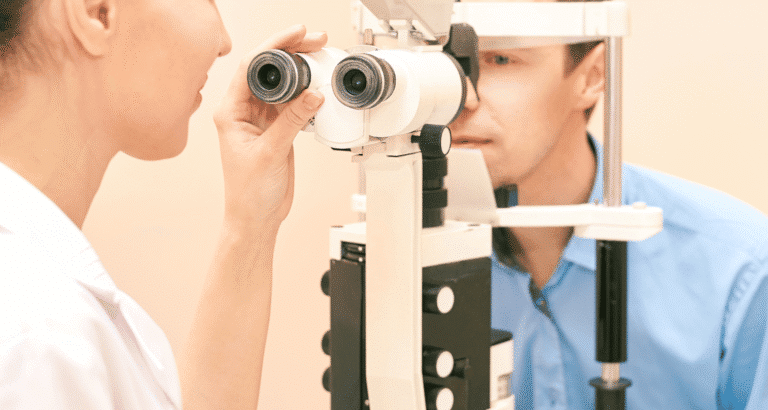We all have sensitive eyes, so it is very easy to worry when any minor annoyance shows up. One of the most common concerns people have is determining how to recognize an eye infection. And because eye infections can be caused by various factors and range in severity, from mild conjunctivitis to more serious bacterial infections, it’s essential to recognize the signs, receive proper care, and prevent anything from worsening. In today’s blog, we’ll dig into the most common symptoms, causes, and when to see a medical professional.
Signs of Eye Infection
Symptoms of an eye infection. Eye infections typically begin subtly, emerging as mild irritation or redness but escalating rapidly when left untreated. Attention should be paid early, as these symptoms may quickly evolve, causing pain or visual disturbance.
- Redness: If redness persists in one or both eyes, it may indicate an infection rather than mere irritation.
- Discomfort: Light itching may indicate allergies, but if you experience burning or sharp pain, or if it feels like something’s gritty in your eye, an infection is a likely cause.
- Swelling: Taut eyelids or swelling around the eye socket might be a red flag.
- Discharge: If the discharge is thick, yellow, or green, it can be a sign of bacterial infection.
- Crusting: Awaking with your lids glued together is a common symptom of conjunctivitis (pink eye).
- Sensitivity to light: If you suddenly find yourself dreading bright light, it may be a sign of an infection.
Recognizing these symptoms enables a clinician to differentiate between an infection and irritation caused by dust, smoke, or allergies.
Eye Infection Symptoms
When discussing symptoms of eye infections, it’s helpful to categorize them according to the specific type of infection, as each condition has unique symptoms, ranging from simple irritation to those that can be so severe that vision may be endangered without treatment.
- Bacterial conjunctivitis: Red, Irritated; Yellow or green discharge. It frequently infects both eyes and is highly contagious.
- Viral Conjunctivitis: Typically starts in one eye with a watery discharge and spreads to the next eye. Highly contagious, but it usually goes away on its own.
- Fungal Infections: A rarer but more severe infection, usually caused by injury or contact with plant material or through contact with plant material.
- Styes (Hordeolum): A tender lump, typically near the edge of the eyelid, resulting from obstruction of an oil gland.
- Keratitis: Inflammation of the cornea associated with contact lens use, resulting in blurry vision and eye pain.
These symptoms are among the reasons why you should not overlook those unusual eye changes.
Red Eye Discharge Infection
For many suffering from them, a red eye discharge infection can be one of the most alarming and annoying symptoms. This discharge can be watery, mucus-like, or pus-like, with the color and consistency of the material often indicating the underlying cause of the problem.
- Clear and Watery: Often due to viruses or allergies.
- Yellow/Green and Thick: This is typical of bacterial infections.
- Sticky & Crusty: It is often a symptom of conjunctivitis, also known as pink eye.
If discharge persists for extended periods, particularly accompanied by redness or pain, consult a healthcare professional to prevent potential complications.
How Can I Tell If I Have Pink Eye?
One of the most common and crucial questions people ask is: How do I know if I have conjunctivitis, also known as pink eye? Pink eye, also known as conjunctivitis, is one of the most common forms of eye infections. You may suspect pink eye if:
- Your eye appears pink or red.
- There’s noticeable swelling.
- You jolt awake with your eyelids sticky.
- Your eye is itchy or feels gritty.
- You see either white or colored discharge.
While pink eye is highly contagious, spreading quickly through direct contact, practicing good hygiene, such as frequent hand washing, avoiding eye contact, and not sharing towels or cosmetics, is of utmost importance, Dr. Shah said.
Causes Of Eye Pain And Discharge Causes
Signs of Eye Pain and Discharge. Another factor to consider in assessing eye health is the causes of eye pain and discharge. Such uncomfortable symptoms can be caused by a variety of issues, which have their own sets of sources, from bad habits to infections.
- Bacterial or Viral Infections: These are (as stated) the most likely culprits of your aching emission.
- Blocked Tear Ducts: May present with chronic tearing and infection.
- Misuse of Contact Lenses: Falling asleep in unclean or contaminated lenses can cause infection.
- Corneal Ulcerations: Open sores in the cornea can cause pain, redness, and discharge.
- Foreign Objects: Causes of Eye Pain and Discharge, as well as an infection hazard.
If you experience severe pain or notice a change in your vision, consult a doctor immediately.
Is My Eye Infected?
It’s only normal to ask: Is my eye infected? Answering a few key questions about your symptoms, how red they are, how much pain you’re in, whether anything is draining from the eye, and if your vision has changed at all, can help you assess things more clearly.
- Is the redness getting worse or better?
- Am I experiencing discharge that is unclear and watery?
- Does my eye hurt or feel scratchy?
- Are my eyelids droopy or swollen?
- Do I have blurred or sensitive vision?
If you say “yes” to many of these, an infection is likely involved rather than mere irritation or dryness.

How to Treat Eye Infections
When you first start to suspect an eye infection, you must know how to treat the symptoms of the eyelid infection correctly. The optimal treatment depends mainly on the type of infection and its underlying etiology.
- Bacterial infections are usually managed with antibiotic eye drops or ointments, which your doctor can prescribe.
- Viral Infections: Viral infections are usually handled by the body itself; however, cool compresses and artificial tears can help alleviate discomfort.
- Allergic Reactions: Antihistamine or anti-inflammatory drops can work.
- Styes: Warm compresses may expedite healing; more prolonged cases may need drainage by a doctor.
- Fungal Infections: Prescription antifungal drugs should be obtained and never neglected
Don’t self-diagnose and head for the over-the-counter drops without consulting a doctor. Applying the wrong treatment can exacerbate the problem.
Eye Infection vs Allergy Symptoms
Many people become confused between eye infections and allergies because some symptoms can appear similar. So, what can you do to determine whether you have an eye infection or allergy symptoms and receive the care you need?
- Allergies: Typically, they cause both eyes to itch, water, and swell. Symptoms tend to occur during specific seasons or after exposure to allergens such as pollen, pets, or dust.
- Infections: Commonly begin in a single eye, include discharge that isn’t clear and can be painful or make your eyes sensitive to light.
If your eyes feel itchy rather than hurt, and if the symptoms wax and wane according to allergen exposure, allergies are more likely. However, continued drainage and redness suggest an infection.
When to Contact a Medical Professional for Eye Infection
Eye infections are sometimes mistaken for allergic reactions, as some of the signs can be similar. So, how do you properly distinguish between eye infection and allergy symptoms, and how can you ensure that you receive the appropriate care and treatment?
- Severe or increasing eye pain.
- Sudden vision changes.
- Thick yellow or green discharge.
- High sensitivity to light.
- Persistent symptoms that last longer than a couple of days.
- History of eye surgery or contact lens wear within the past year.
If caught early, treatment may help combat serious complications, such as corneal damage or loss of vision.
Conclusion
Your eyes are precious, and you should always be vigilant for early warning signs. Whether you want to know “Is my eye infected? Or when attempting to differentiate between symptoms of an eye infection and an allergy, the key is understanding when it’s time to seek assistance. From redness and drainage to pain and swelling, eye infections are nothing to glance over. If you experience any of these symptoms, consult an eye professional immediately. For quality care and expert assessment, contact Barnes Talero Eyecare, your committed vision partner!





